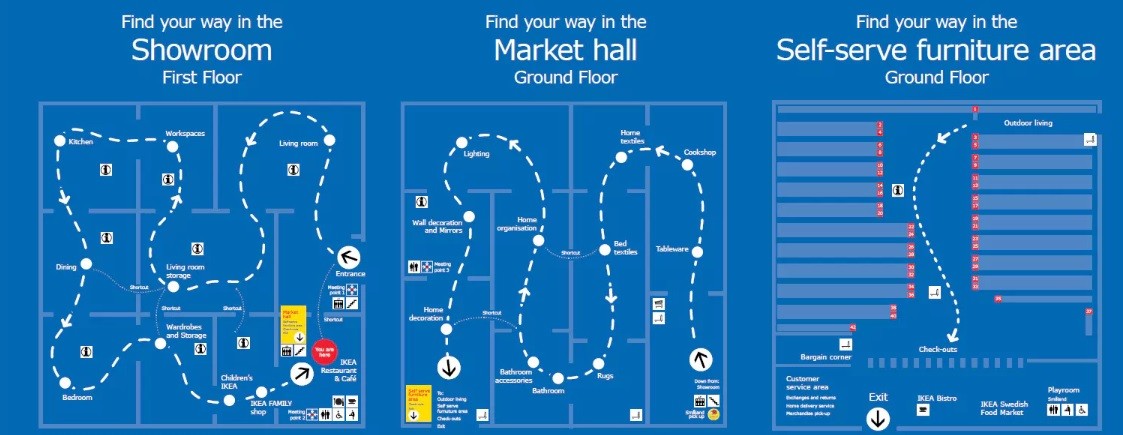Your competitors probably know more about your customers than you do, and they are using that information to win fiercely.
If not, how else would retail stores like Target, DSW, and Macy’s have predicted the need for more physical stores even after the COVID-19 pandemic?
The fact is, they had access to the right data, which informed their decisions.
Till today, many retailers are using the same data to track every trend, predict demand, and personalize experiences before you (their competitor) even notice the shift.
But you can change that. With the right data science strategy, you can take back control, understand your customers deeply, and stay ahead.
In this article, we’ll discuss the impact of data science in retail and how you can start benefiting from it.
What Data Science is Not About (Shattering Common Myths About Data Analytics in Retail)
Before we start uncovering different ways that many are winning by leveraging data science in the retail industry, we need to clear the fog.
Yes, data science involves analyzing data to extract meaningful insights for your business. While the focus is clear, certain misconceptions and limiting beliefs still hold a few retailers back from benefiting fully from it.
Today, most retailers believe that data science is:
- Just for enterprise companies with massive budgets
- A one-time project
- The same as basic reporting in Excel
- Something only analysts or IT teams should care about
- Something that continues running like magic when set up
Realistically, data science requires more than access to the right tool. Its successful execution relies on expertise, a mindset shift, and access to the right data. Without all of these in place, retailers risk wasting valuable time and resources.
Therefore, invest qualitatively in working with data scientists with a proven record of expertise to avoid resource wastage.
Now that we’ve cleared up some of the myths, let’s discuss different innovative ways retailers like you are adopting data science.
Applications of Data Science in the Retail Industry With Examples
Data science has continued to evolve and adapt to technological advancements. This evolution also shaped how retailers have used data to make meaningful business decisions.
From the early days when A&P used handwritten grocery diaries to improve operations, to today’s AI-powered insights, the core goal hasn’t changed: understand customers, stay ahead of the competition, and drive growth.
And with data science projected to keep growing through 2028 and beyond, now’s the time to explore how it can work for you.
Let’s uncover today’s most effective application of data science in retail, use cases with examples.
Dynamic Pricing
With the introduction of the internet, the world is now a global village. Shoppers can compare prices in a few seconds right on their phones to make the right buying decision that suits their budgets, making sales more competitive than ever. This is where data science comes in to rescue retailers. It provides them with the tools needed to adjust prices in real time based on actual market activity.
This approach, known as dynamic pricing, relies on data inputs like demand, competitor pricing, time of the day, and inventory levels to fine-tune prices. For instance, an online store can raise the cost of a fast-selling product or drop the price of slower-moving stock to encourage sales.
This pricing strategy helps retailers increase profits while staying competitive. At the same time, it gives customers a sense of fairness.
In fact, a recent survey of 1,000 shoppers across the US revealed that almost half (46%) believe electronic shelf labels (ESLs), which allow grocery retailers to adjust prices in real time, offer them better value.
Walmart shows how powerful this can be. Through Walmart Labs, the company collects over 2.5 petabytes of customer data every hour from more than a million customers. With this information, they could adjust prices on millions of products in real time. But it all stemmed from preparation with the right data. Walmart’s former CEO summed it up like this:
“We want to know what every product in the world is. We want to know who every person in the world is. And we want to have the ability to connect them together in a transaction.”
By using data in this way, Walmart stays competitive and keeps its pricing strategy aligned with real customer behavior. You don’t have to be a global giant to do the same. With the right data tools and expertise, retailers of any size can make smarter pricing decisions and protect their bottom line.
Discover Customer Shopping Patterns and Trends
Customers’ behaviour is very complex to understand, but understanding it is essential for a profitable retail business. The good news is that data science makes this easier.
With techniques from machine learning and predictive analytics, retailers can track and analyze shopping patterns, search queries, web traffic, social media trends, and seasonal product interest. These insights reveal what customers want and how they shop.
A major caveat is that customer data often comes from many sources. To make sense of it and eliminate data silos, retailers need to consolidate data into a single dashboard. This usually requires expertise in data engineering. When you’re ready, think GAP.
With access to a 360-degree data report, retailers can get clearer insights to launch well-targeted campaigns, optimize their store layout, and even design products that customers are more likely to buy.
Nike, a global footwear brand, relies heavily on customers’ data through diverse data points such as their fitness mobile app and in-store data. Then it went further in its data collection pursuit by acquiring a data analytics company called Zodiac. This way, the company is able to understand buying habits and triggers at a deeper level.
Inventory and Supply Chain Management
One of the biggest advantages data science offers retailers is knowing what to sell, where to sell it, and when. No retailer wants to experience stockouts or overstocking of non-trendy products. They want to be able to balance the supply and demand levels. However, it requires access to smart data collection and analysis.
With predictive analytics, retailers can leverage historical sales data, market trends, and even weather forecasts to anticipate demand more accurately. This allows them to stock just the right products in the right locations, reducing waste and improving customer experience.
Also, retailers can easily optimize their supply chain to avoid overstocking items that aren’t in demand. When done right, the result is a balanced inventory and products that are available exactly when customers want them.
Zara does this well. This fast-fashion brand uses business intelligence to understand real-time sales data and customer feedback to adjust production and distribution. Using proper data collection techniques keeps their inventory lean, their operations agile, and their shelves stocked with what customers actually want.
Determining New Store Location
At the growth phase, retailers don’t just want to meet customers’ needs; they want to meet them across different locations physically and online. That’s why knowing the exact new location is such a big deal.
At the same time, opening a new store isn’t just about finding a space. You need to know if that location will drive sales by considering elements like competition, accessibility to customers, proper zoning, and determining the right products customers want.
Starbucks is a good example of a retail business that has used data science to determine store locations. They adopted location-based analytics powered by Atlas to make strategic location decisions. According to a publication about Starbucks’ data process,
“Before finalizing or selecting a new store location, Starbucks evaluates massive amounts of data, including factors like visitor traffic, population, income levels, nearby competitor presence, and proximity to other Starbucks locations. Based on this information, the company forecasts revenue, profits, and other aspects of economic performance for that location.”
This data-first approach has helped Starbucks scale with precision with at least one new store every tenth of a square mile.
If you’re looking to grow your retail store, you could strategically employ data to choose locations with higher chances of success.
Customer Segmentation and Personalization
Shoppers want a personalized shopping experience, and this is quickly becoming a key success driver in modern retail. Although this demand starts with the customer, it also gives retailers the insight they need to promote the right products and choose the most effective marketing strategies.
Even if you have a small customer database, say fewer than 100 people, manually analyzing their behavior in a spreadsheet or jumping between dashboards is time-consuming and absolutely ineffective. However, data analysis becomes the solution to automatically segment your customers, helping you determine the right content, products, and offers for each customer.
Another reason why data science is the go-to solution is that data consolidation across different touchpoints makes valuable data accessible. With tools like natural language processing, you can turn reviews, surveys, and customer feedback into clear insights. This helps you:
- identify buying patterns,
- understand customer preferences at specific times of day, and
- tailor your marketing strategy to meet their actual needs.
So instead of sending out generic marketing messages, you can reconnect with people who abandoned their carts or send promotions when customers are most likely to engage.
To show the worth of personalization, McKinsey’s research shows that it can increase revenue by up to 15% and significantly cut down acquisition costs by 50%. What an amazing money-saving hack for retailers.
A good example of a retail data science use case is Amazon.
Amazon is known for its innovative use of data to improve customer experience, which involves the collection of every interaction, search, and navigation detail. With machine learning and AI, they scrutinize this data to deliver highly personalized product recommendations, deals, and promotions for each user. This is one reason their shopping experience feels intuitive and relevant every time.
Read more about GAP’s customer personalization project for a client.
Optimizing Store Layout
Just as online stores are optimized for search visibility and smooth navigation, physical walk-in stores are not left behind. It’s often about making it easy for shoppers to discover products and make purchasing decisions quickly.
Optimizing store layout implies arranging your products based on customer behaviour and not guesswork. With tools like machine learning, sales analytics, foot traffic sensors, and feedback systems, you can make informed decisions about how to position products for maximum visibility and conversion.
IKEA is another example of a retail data science application that combines data and customer psychology to inform its store layout. Their unique maze-like layout encourages discovery and nudges shoppers to pick up items as they move through the space, reducing the need to backtrack.

Rather than assuming, they analyze customer behavior and trends to fine-tune their store layout for better engagement and improved product discovery.
We also have one of our clients who improved customer experience with Enhanced Display for Grocery Environments (EDGE) shelving across their stores. This means that there’s no one way to optimize your store for more sales.
You only need to work with data scientists to figure out the best approach for you.
Ready to Take Your Retail Store to the Next Level?
There’s a common thread in every example shared in this article: the power of building a strong data bank for smarter decision-making.
Now, it’s your turn.
Will you keep relying on guesswork that drains time and resources, or take control by building a competitive data channel that drives real results?
Choosing the latter means you can predict which products to promote, make smarter marketing investments, and deliver the kind of shopping experience your customers keep coming back for.
If you’re ready to take the manual analysis out of your retail business, book a free consultation with GAP’s data experts today. We’ll help you design a tailored data workflow that uncovers hidden opportunities and boosts performance.
Not only are we experienced with data engineering, but we are also experienced in other skill sets required to drive your retail business analytical project to success. Skills such as machine learning, AI consultation, custom AI software development, and modernization.
Let’s talk and build a competitive data solution for your retail business.



